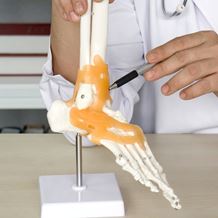Dislocated Ankle
- Home
- Services
- Orthopaedics
- Ankle Orthopaedics
- Common Ankle Conditions
- Dislocated Ankle
What is a dislocated ankle?
A dislocated ankle is a serious ankle injury that requires immediate medical attention. It usually occurs when the ankle bone (talus) is forced out of its normal position under the lower leg bones and dislocated as a result of sudden force, such as from a car accident or high-impact collision. Ankle dislocation is considered a very severe injury, and it usually happens in conjunction with an ankle fracture, or ligament rupture. Common symptoms include a popping sound, immediate pain, a visible deformity and inability to move. In severe cases, the bone may protrude through the skin.
How is it treated?
Ankle dislocations require immediate medical attention, and an X-Ray can usually determine which ankle bones have been affected and the direction of the dislocation. Other imaging may be required to ascertain the level of soft tissue damage. The next step is to move the ankle bones back into their natural position. This is known as a reduction, and may require pain relief to help relax the muscles. Once the bones are realigned, the ankle will be immobilised as it begins to heal. If an ankle fracture has also occurred with the dislocation, surgery may be necessary to relocate the bone and repair the fracture.
How long does it last?
Ankle dislocations are generally always considered a serious injury, and the recovery time will depend on the extent of the treatment required. If surgery is not required, physiotherapy exercises can begin as soon as you are cleared to move your ankle. This will help prevent stiffness and build up strength. It can take several months before your ankle recovers but it may not ever return to full strength. If fracture-repair surgery is required, the recovery will take considerably longer. You are likely to be non-weight bearing for the first 2-3 weeks, and in a removeable boot for 6 weeks. No strength or weight-bearing exercises can begin until medically approved. A gradual return to sport will start from 12 weeks, but swelling can persist for up to a year.

Other ankle surgeries and procedures
- Ankle Ligament Surgery
- Ankle Arthroscopy
- Suture Button Ankle Surgery
- Ankle Reconstruction Surgery
- Ankle Fusion
- Ankle Replacement Surgery
- Ankle Fracture Treatment
- Achilles Tendon Surgery
Common ankle conditions
Find a hospital with orthopaedic services
Our Hospitals



